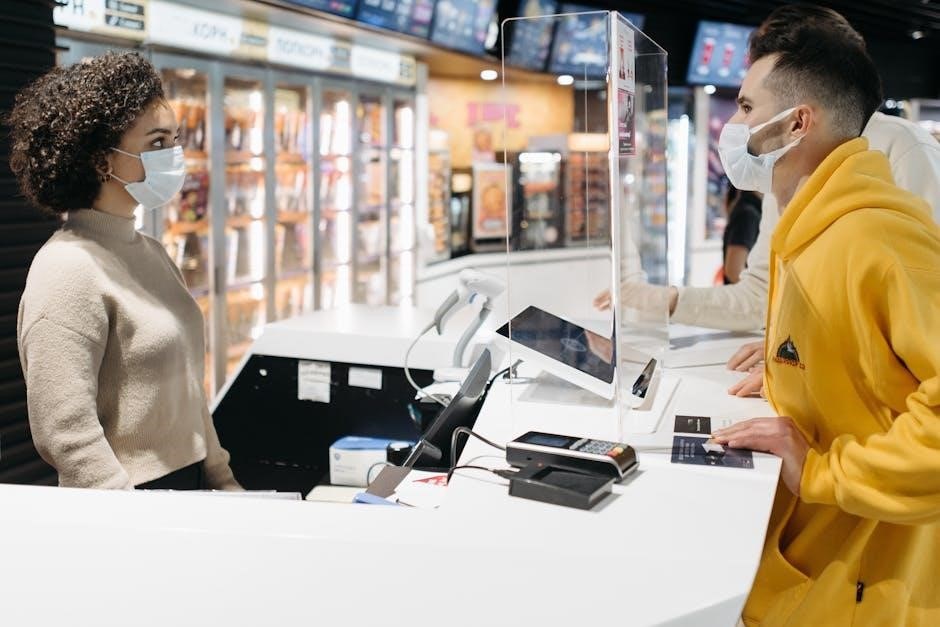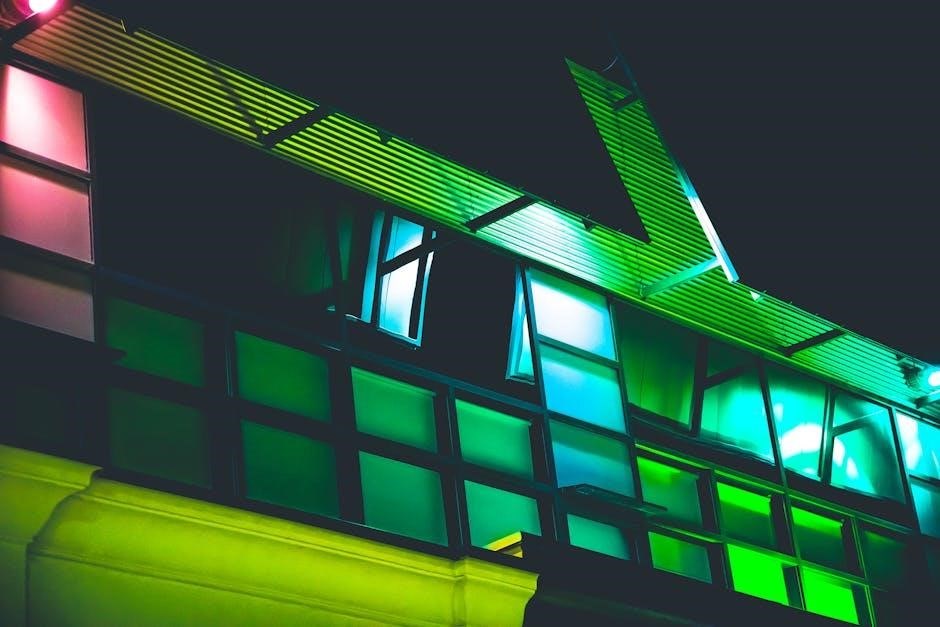Plexiglass, a versatile acrylic material, is shatterproof, lightweight, and weather-resistant, making it ideal for dividers, signs, and displays in various indoor and outdoor settings.
1.1 What is Plexiglass?
Plexiglass, often referred to as acrylic glass, is a lightweight, shatterproof, and weather-resistant material made from polymethyl methacrylate (PMMA). Known for its exceptional clarity and durability, it is widely used in applications requiring transparency and strength. Plexiglass is a popular alternative to traditional glass due to its ease of fabrication, resistance to impact, and ability to withstand harsh environments. Its versatility makes it a preferred choice for indoor and outdoor uses, such as signage, displays, and protective barriers. Plexiglass is also known for its UV resistance, ensuring minimal discoloration over time, making it ideal for long-term installations and projects.
1.2 Advantages of Using Plexiglass
Plexiglass offers numerous advantages, including its lightweight nature, making it easier to handle and install compared to traditional glass. Its shatterproof property enhances safety, reducing risks of injury from breakage. High clarity ensures minimal distortion, making it ideal for displays and signage. Weather resistance and UV stability prevent discoloration and degradation, ensuring prolonged durability outdoors. Additionally, plexiglass is cost-effective and can be easily fabricated into various shapes and sizes. These benefits make it a preferred material for diverse applications, from public dividers to decorative installations.
Types of Plexiglass
Plexiglass is available in two main types: extruded and cast acrylic sheets. Each offers unique properties suited for specific applications, from signage to fabrication projects.
2.1 Extruded Plexiglass
Extruded plexiglass is produced through an extrusion process, making it more affordable and suitable for large-scale production. It offers excellent optical clarity, durability, and is ideal for lightweight applications such as signage, displays, and decorative elements. This type of acrylic is less prone to stress cracks and is easier to fabricate, making it a popular choice for commercial and DIY projects. Its flexibility and resistance to weathering also make it suitable for outdoor use, ensuring long-lasting performance in various environments.
2.2 Cast Plexiglass
Cast plexiglass is manufactured through a casting process, resulting in a material with superior thickness tolerance and a highly polished finish. It is more rigid and less likely to bend under stress compared to extruded acrylic, making it ideal for demanding applications such as optical components, high-end signage, and intricate fabrications. Cast plexiglass also offers excellent impact resistance and thermal stability, making it suitable for industrial and architectural uses. Its durability and ability to maintain clarity over time ensure it is a preferred choice for projects requiring high precision and long-term reliability.

Common Applications of Plexiglass
Plexiglass is widely used in public spaces, offices, and commercial settings for dividers, signs, and displays due to its versatility, shatterproof nature, and lightweight properties.
3.1 Plexiglass Dividers in Public Spaces
Plexiglass dividers have become essential in public spaces, particularly during the pandemic, to ensure safety and social distancing. They are commonly installed in restaurants, grocery stores, banks, and public transportation. Clear and durable, these dividers provide a protective barrier while maintaining visibility. Their lightweight and weather-resistant properties make them suitable for both indoor and outdoor use. Additionally, plexiglass dividers are easy to clean and sanitize, further enhancing their practicality in high-traffic areas. Many businesses also customize them with branding or informational graphics, making them functional and visually appealing.
3.2 Use in Office and Commercial Settings
Plexiglass has become a staple in office and commercial environments, particularly for creating safe spaces while maintaining visibility. It is widely used in office cubicles, desk shields, and meeting room partitions to promote social distancing without compromising natural light. Its durability and ease of installation make it a cost-effective solution for businesses. Additionally, plexiglass is used in commercial spaces like retail stores and banks to protect employees and customers. It is also utilized for signage and displays, enhancing both functionality and aesthetics. The material’s versatility allows it to adapt to various settings, ensuring safety and efficiency in professional environments.
How to Cut Plexiglass
Cutting plexiglass requires clamping the sheet firmly and using a Dremel with a 561 bit at speed six or eight for precise, smooth cuts.
4.1 Step-by-Step Guide to Cutting Plexiglass
To cut plexiglass, start by clamping the sheet firmly to your work surface. Use a Dremel with a 561 bit set at speed six or eight for smooth cuts. Ensure the material is secure to prevent vibrations. Wearing safety goggles and a dust mask is essential. Carefully guide the tool along your marked line, maintaining steady pressure. For thicker sheets, a saw may be necessary. After cutting, sand the edges to remove any rough spots. This method ensures clean, precise cuts for your project, making plexiglass easy to work with for both professionals and DIY enthusiasts.
4.2 Tools Needed for Cutting Plexiglass
Essential tools for cutting plexiglass include a Dremel with a 561 cutting bit, set at speeds 6 or 8 for smooth results. Safety goggles and a dust mask are crucial for protection. A sturdy clamp or vice ensures the sheet remains stable during cutting. A workbench provides a flat, secure surface. For precise cuts, use a ruler or measuring guide. Thicker sheets may require a circular saw or jigsaw. Sandpaper or a polishing compound is needed to smooth edges post-cutting. Optional tools include utility knives or glass cutters for scoring thinner sheets. Always ensure tools are sharp to avoid cracking the material.

Maintenance and Care
Regular cleaning with Novus 1 prevents scratches and maintains clarity. Use Novus 2 or 3 for repairs. Avoid harsh chemicals and abrasive materials. Soft cloths are best for cleaning.
5.1 Cleaning Tips for Plexiglass
Regular cleaning with Novus 1 is essential to maintain plexiglass clarity and prevent scratches. Use a soft, lint-free cloth or microfiber to wipe surfaces gently in circular motions. Avoid harsh chemicals, abrasive materials, or paper towels, as they may damage the acrylic. For tougher smudges, Novus 2 or 3 can be used sparingly. Always dry plexiglass thoroughly after cleaning to prevent water spots. Cleaning frequency depends on exposure to dust or contaminants. Proper care ensures plexiglass remains durable and visually appealing for years.
5.2 Protecting Plexiglass from Scratches
To protect plexiglass from scratches, use protective films during transportation or installation. Apply scratch-resistant coatings or polishes like Novus 2 or 3 for added durability. In high-traffic areas, consider placing felt or rubber pads on surfaces that may come into contact with the acrylic. Avoid placing sharp or heavy objects directly on plexiglass. Regular cleaning with Novus 1 prevents dust buildup, which can lead to scratches during wiping. Use soft, lint-free cloths or microfiber to clean, and avoid abrasive materials or paper towels. Proper handling and storage will ensure your plexiglass remains scratch-free and maintains its clarity and appearance.

Working with Plexiglass
Working with plexiglass involves drilling, polishing, and fabrication techniques. Use tools like Dremel with a 561 bit at speed six or eight for precise cuts. Versatile and durable, plexiglass is ideal for various projects.
6.1 Drilling and Polishing Plexiglass
Drilling and polishing plexiglass requires precision to avoid cracks. Start with a pilot hole using a sharp drill bit at low speed. Gradually increase drill size for larger holes. After drilling, polish edges with progressively finer sandpaper, finishing with a buffing wheel. Use Novus 2 or 3 for minor scratches, restoring clarity. Regular cleaning with Novus 1 maintains surface quality. Proper polishing ensures a smooth finish, enhancing the material’s aesthetic appeal for professional results in various applications, from signs to displays.
6.2 Fabrication Techniques for Acrylic Sheets
Fabrication of acrylic sheets involves cutting, bending, and shaping to achieve desired forms. Use a Dremel or Festool for precise cuts, ensuring smooth edges. For bending, apply heat evenly to avoid warping. Polishing with progressively finer abrasives enhances clarity and removes imperfections. Always use appropriate tools and techniques to maintain material integrity. Proper fabrication ensures durability and a professional finish, making acrylic sheets ideal for signs, displays, and custom projects. Regular maintenance with Novus products helps preserve their appearance and functionality over time, ensuring long-lasting results in various applications.

Choosing the Right Plexiglass
Evaluate project requirements, material thickness, and intended use to select the right plexiglass. Consider durability and application-specific needs for optimal results. Consult guides or experts.
7.1 Factors to Consider for Your Project
When selecting plexiglass, consider thickness for structural integrity, clarity for visual purposes, and environmental exposure. Assess load-bearing needs and whether additional treatments like UV resistance are required. Ensure the material aligns with your project’s specific demands for durability and aesthetics, optimizing both functionality and appearance while maintaining cost-effectiveness. Proper selection ensures long-lasting performance in various applications.
7.2 Plexiglass vs. Polycarbonate: Key Differences
Plexiglass and Polycarbonate are both transparent plastics but differ significantly. Plexiglass, or acrylic, offers high optical clarity, is lightweight, and cost-effective, making it ideal for displays and signs. Polycarbonate, while heavier and less clear, excels in impact resistance, often used in safety gear and durable applications. Plexiglass is easier to fabricate but less resistant to scratches and heat, whereas Polycarbonate is tougher and suitable for high-impact environments. Choosing between them depends on the need for clarity versus strength, budget, and the specific demands of the project.